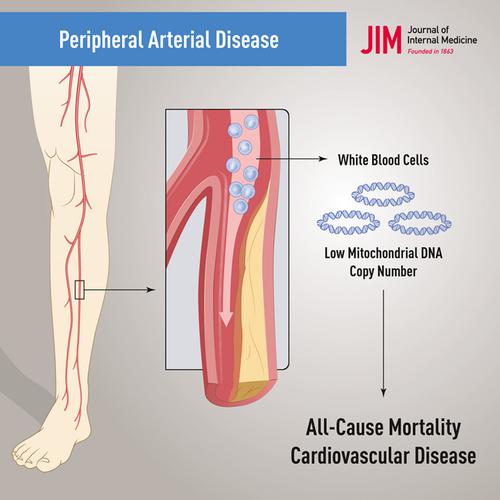当前位置:
X-MOL 学术
›
J. Intern. Med.
›
论文详情
Our official English website, www.x-mol.net, welcomes your
feedback! (Note: you will need to create a separate account there.)
Mitochondrial DNA copy number is associated with all-cause mortality and cardiovascular events in patients with peripheral arterial disease.
Journal of Internal Medicine ( IF 9.0 ) Pub Date : 2020-02-09 , DOI: 10.1111/joim.13027 A Koller 1 , F Fazzini 1 , C Lamina 1 , B Rantner 2 , B Kollerits 1 , M Stadler 3, 4 , P Klein-Weigel 5 , G Fraedrich 2 , F Kronenberg 1
Journal of Internal Medicine ( IF 9.0 ) Pub Date : 2020-02-09 , DOI: 10.1111/joim.13027 A Koller 1 , F Fazzini 1 , C Lamina 1 , B Rantner 2 , B Kollerits 1 , M Stadler 3, 4 , P Klein-Weigel 5 , G Fraedrich 2 , F Kronenberg 1
Affiliation

|
BACKGROUND
Dysfunctional mitochondria have an influence on inflammation and increased oxidative stress due to an excessive production of reactive oxygen species. The mitochondrial DNA copy number (mtDNA-CN) is a potential biomarker for mitochondrial dysfunction and has been associated with various diseases. However, results were partially contrasting which might have been caused by methodological difficulties to quantify mtDNA-CN.
OBJECTIVE
We aimed to investigate whether mtDNA-CN is associated with peripheral arterial disease (PAD) as well as all-cause mortality and cardiovascular events during seven years of follow-up.
METHODS
A total of 236 male patients with PAD from the Cardiovascular Disease in Intermittent Claudication (CAVASIC) study were compared with 249 age- and diabetes-matched controls. MtDNA-CN was measured with a well-standardized plasmid-normalized quantitative PCR-based assay determining the ratio between mtDNA-CN and nuclear DNA.
RESULTS
Individuals in the lowest quartile of mtDNA-CN had a twofold increased risk for PAD which, however, was no longer significant after adjusting for leukocytes and platelets. About 67 of the 236 patients had already experienced a cardiovascular event at baseline and those in the lowest mtDNA-CN quartile had a 2.34-fold increased risk for these events (95% CI 1.08-5.13). During follow-up, 37 PAD patients died and 66 patients experienced a cardiovascular event. Patients in the lowest mtDNA-CN quartile had hazard ratios of 2.66 (95% CI 1.27-5.58) for all-cause-mortality and 1.82 (95% CI 1.02-3.27) for cardiovascular events compared with the combined quartile 2-4 (adjusted for age, smoking, CRP, diabetes, prevalent cardiovascular disease, leukocytes and platelets).
CONCLUSION
This investigation supports the hypothesis of mitochondrial dysfunction in peripheral arterial disease and shows an association of low mtDNA-CNs with all-cause-mortality and prevalent and incident cardiovascular disease in PAD patients with intermittent claudication.
中文翻译:

线粒体DNA拷贝数与外周动脉疾病患者的全因死亡率和心血管事件有关。
背景技术功能性线粒体由于过度产生活性氧而对炎症和氧化应激增加有影响。线粒体DNA拷贝数(mtDNA-CN)是线粒体功能障碍的潜在生物标记,并已与多种疾病相关。但是,结果存在部分差异,这可能是由于量化mtDNA-CN的方法学困难所致。目的我们旨在调查在长达7年的随访中mtDNA-CN是否与周围动脉疾病(PAD)以及全因死亡率和心血管事件相关。方法将总共236名来自间歇性lau行性心血管疾病的PAD男性患者与249名年龄和糖尿病匹配的对照组进行比较。MtDNA-CN用高度标准化的基于质粒标准化,基于定量PCR的测定方法进行测定,从而确定mtDNA-CN与核DNA的比例。结果mtDNA-CN最低四分位数的人患PAD的风险增加了两倍,但是在调整白细胞和血小板后,PAD的风险不再显着。236名患者中约有67名在基线时已发生心血管事件,而mtDNA-CN四分位数最低的患者发生这些事件的风险增加了2.34倍(95%CI 1.08-5.13)。在随访期间,有37位PAD患者死亡,有66位患者发生了心血管事件。与合并的四分位数2-4(调整后)相比,处于最低mtDNA-CN四分位数的患者的全因死亡率危险比为2.66(95%CI 1.27-5.58),心血管事件的危险比为1.82(95%CI 1.02-3.27)年龄,吸烟,CRP,糖尿病,普遍的心血管疾病,白细胞和血小板)。结论这项研究支持外周动脉疾病中线粒体功能障碍的假说,并显示了在行间歇性lau行的PAD患者中,低线粒体DNA-CNs与全因死亡率以及普遍和偶然的心血管疾病相关。
更新日期:2020-02-09
中文翻译:

线粒体DNA拷贝数与外周动脉疾病患者的全因死亡率和心血管事件有关。
背景技术功能性线粒体由于过度产生活性氧而对炎症和氧化应激增加有影响。线粒体DNA拷贝数(mtDNA-CN)是线粒体功能障碍的潜在生物标记,并已与多种疾病相关。但是,结果存在部分差异,这可能是由于量化mtDNA-CN的方法学困难所致。目的我们旨在调查在长达7年的随访中mtDNA-CN是否与周围动脉疾病(PAD)以及全因死亡率和心血管事件相关。方法将总共236名来自间歇性lau行性心血管疾病的PAD男性患者与249名年龄和糖尿病匹配的对照组进行比较。MtDNA-CN用高度标准化的基于质粒标准化,基于定量PCR的测定方法进行测定,从而确定mtDNA-CN与核DNA的比例。结果mtDNA-CN最低四分位数的人患PAD的风险增加了两倍,但是在调整白细胞和血小板后,PAD的风险不再显着。236名患者中约有67名在基线时已发生心血管事件,而mtDNA-CN四分位数最低的患者发生这些事件的风险增加了2.34倍(95%CI 1.08-5.13)。在随访期间,有37位PAD患者死亡,有66位患者发生了心血管事件。与合并的四分位数2-4(调整后)相比,处于最低mtDNA-CN四分位数的患者的全因死亡率危险比为2.66(95%CI 1.27-5.58),心血管事件的危险比为1.82(95%CI 1.02-3.27)年龄,吸烟,CRP,糖尿病,普遍的心血管疾病,白细胞和血小板)。结论这项研究支持外周动脉疾病中线粒体功能障碍的假说,并显示了在行间歇性lau行的PAD患者中,低线粒体DNA-CNs与全因死亡率以及普遍和偶然的心血管疾病相关。











































 京公网安备 11010802027423号
京公网安备 11010802027423号